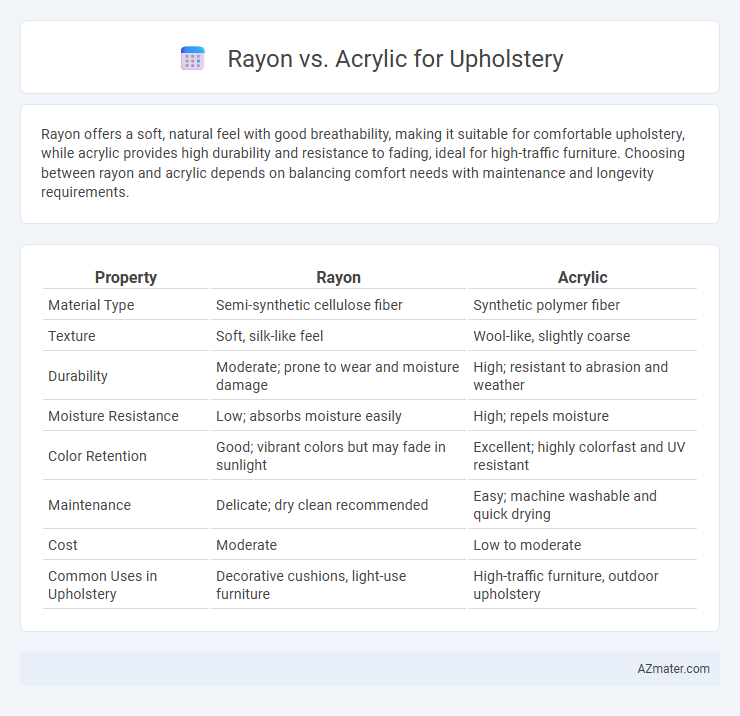Rayon offers a soft, natural feel with good breathability, making it suitable for comfortable upholstery, while acrylic provides high durability and resistance to fading, ideal for high-traffic furniture. Choosing between rayon and acrylic depends on balancing comfort needs with maintenance and longevity requirements.
Table of Comparison
| Property | Rayon | Acrylic |
|---|---|---|
| Material Type | Semi-synthetic cellulose fiber | Synthetic polymer fiber |
| Texture | Soft, silk-like feel | Wool-like, slightly coarse |
| Durability | Moderate; prone to wear and moisture damage | High; resistant to abrasion and weather |
| Moisture Resistance | Low; absorbs moisture easily | High; repels moisture |
| Color Retention | Good; vibrant colors but may fade in sunlight | Excellent; highly colorfast and UV resistant |
| Maintenance | Delicate; dry clean recommended | Easy; machine washable and quick drying |
| Cost | Moderate | Low to moderate |
| Common Uses in Upholstery | Decorative cushions, light-use furniture | High-traffic furniture, outdoor upholstery |
Introduction to Rayon and Acrylic Upholstery Fabrics
Rayon upholstery fabric, derived from regenerated cellulose fibers, offers a soft texture and excellent breathability, making it a popular choice for comfortable furniture coverings. Acrylic upholstery fabric, a synthetic fiber made from polymerized acrylonitrile, provides durability and resistance to sunlight, mildew, and staining, ideal for high-traffic areas. Both materials vary significantly in care requirements and longevity, influencing their suitability for different upholstery applications.
Key Differences: Composition and Manufacturing
Rayon is a semi-synthetic fiber derived from cellulose in wood pulp, created through a chemical process that regenerates natural fibers, resulting in a soft and breathable fabric ideal for upholstery. Acrylic, on the other hand, is a synthetic fiber made from polymerized acrylonitrile, produced through a dry spinning or wet spinning manufacturing process, known for its durability and resistance to stains and fading. The primary difference lies in composition, with rayon offering a more natural feel due to its cellulose base, while acrylic provides enhanced resilience and colorfastness due to its synthetic origin.
Durability Comparison: Rayon vs Acrylic
Rayon offers a soft, luxurious feel but lacks the durability needed for high-traffic upholstery, as it is prone to stretching, fading, and abrasion. Acrylic, on the other hand, provides superior durability with strong resistance to wear, sunlight, and mildew, making it more suitable for upholstery in frequently used furniture. Choosing acrylic ensures longer-lasting fabric performance, while rayon is better reserved for decorative pieces with minimal use.
Comfort and Feel: Which Is Softer for Upholstery?
Rayon offers a smooth, silky texture that mimics natural fibers, providing a soft and breathable feel ideal for upholstery comfort. Acrylic, while warm and lightweight, has a slightly coarser texture that may lack the same level of softness as rayon. For upholstery prioritizing softness and a natural touch, rayon generally outperforms acrylic in comfort and tactile appeal.
Color Retention and Fade Resistance
Rayon upholstery fabrics offer vibrant color initially but tend to have lower fade resistance compared to acrylic, making them less ideal for high-sunlight areas. Acrylic upholstery excels in color retention with superior resistance to fading caused by UV exposure, maintaining brightness over time. Choosing acrylic ensures durable, vivid upholstery colors while rayon may require more careful placement and maintenance to preserve its appearance.
Stain and Moisture Resistance
Acrylic upholstery offers superior stain and moisture resistance compared to rayon, making it a better choice for high-traffic or spill-prone areas. Rayon tends to absorb liquids quickly, leading to potential staining and fabric damage, whereas acrylic fibers repel water and resist staining effectively. This durability in moisture and stain resistance contributes to acrylic's popularity in upholstery applications requiring easy maintenance and longevity.
Maintenance and Cleaning Requirements
Rayon upholstery requires delicate maintenance due to its sensitivity to water and high risk of shrinking or stretching when cleaned improperly, making professional cleaning the best option. Acrylic, on the other hand, is more durable and stain-resistant, allowing for easier spot cleaning with mild detergents and occasional vacuuming to maintain its appearance. Both materials benefit from regular dusting, but acrylic's superior resistance to moisture and chemicals makes it the more practical choice for low-maintenance upholstery.
Sustainability and Environmental Impact
Rayon and acrylic differ significantly in sustainability and environmental impact, with rayon being a semi-synthetic fiber derived from cellulose, often sourced from wood pulp, while acrylic is a fully synthetic fiber made from petroleum-based chemicals. Rayon production involves chemical processing that can release harmful pollutants but is biodegradable, whereas acrylic relies heavily on fossil fuels, generates microplastic pollution, and is not biodegradable, contributing more to long-term environmental damage. Choosing rayon for upholstery supports a lower ecological footprint due to its natural origins, but sustainable sourcing and eco-friendly manufacturing practices are essential to minimize environmental harm.
Cost Analysis: Rayon vs Acrylic Upholstery
Rayon upholstery typically costs more than acrylic due to its complex production process and natural fiber components, which enhance comfort and breathability. Acrylic, made from synthetic fibers, is generally less expensive and offers superior resistance to fading and mildew, making it a cost-effective choice for budget-conscious consumers. When comparing durability and maintenance expenses, acrylic often provides better long-term value despite its lower initial price, especially in high-traffic or outdoor settings.
Best Uses: Choosing the Right Fabric for Your Project
Rayon offers a soft, luxurious feel and excellent drape, making it ideal for decorative upholstery and light-use furniture where comfort and appearance are priorities. Acrylic provides superior durability, resistance to fading, and easy maintenance, suitable for high-traffic areas and outdoor upholstery projects. Selecting between rayon and acrylic depends on the balance between aesthetic appeal and functional performance required for your specific upholstery needs.

Infographic: Rayon vs Acrylic for Upholstery
 azmater.com
azmater.com